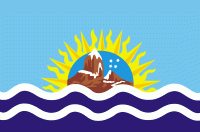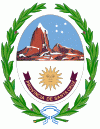Santa Cruz Province (Santa Cruz Province)
 |
 |
The indigenous people of the province are the Tehuelches, who despite European exploration from the 16th century onwards, retained independence until the late 19th century. Soon after the Conquest of the Desert in the 1870s, the area was organised as the Territory of Santa Cruz, named after its original capital in Puerto Santa Cruz. The capital moved to Rio Gallegos in 1888 and has remained there ever since. Immigrants from various European countries came to the territory in the late 19th and early 20th century during a gold rush. Santa Cruz became a province of Argentina in 1957.
The Tehuelches inhabited these lands before the arrivals of the Spanish colonisation. In 1520 Ferdinand Magellan arrived to what is currently known as San Julián Bay. 15 years later Martín de Alcazaba explored the area near the Chico River, which he named Gallegos River. Because of the attacks of British privateers, and after the visit of Francis Drake in 1578, the Spaniards sent Pedro Sarmiento de Gamboa to fortify and map the Strait of Magellan and prevent access to Spanish posts in the Pacific.
In the middle of the 18th century, the Jesuits settled in the area, establishing a few missions. When the Viceroyalty of the Río de la Plata was created in 1776, the region was set under the rule of Buenos Aires. Antonio de Biedma founded Nueva Colonia near present Puerto Deseado and Floridablanca not far from Puerto San Julián, both of them shut down later by Viceroy Vertíz.
Between 1825 and 1836 there were a series of explorations of the regions, including that of Charles Darwin in 1834. In 1860 commander Luis Piedrabuena established a base on Isla Pavón in the estuary of Puerto Deseado.
In 1878 the Government of Patagonia was created, with capital in Viedma, but six years later it was split into smaller entities, with the territory declared National Government of Santa Cruz, whose capital was the city of Santa Cruz. In 1901 the capital was moved to its current location at the city of Río Gallegos.
At the beginning of the 20th century, a large European immigration began to arrive to the almost uninhabited zone; Spanish, Germans, British and Slavs were the most numerous among them. They came mainly to escape the growing conflicts of World War I, and were attracted by the wool industry of the area. The beginning of the war meant a sharp reduction in the amount of exports, bringing a serious economic crisis to Santa Cruz.
The ideals of progressivism, brought by the Spanish immigrants, grew among the workers who, working in Santa Cruz's harsh environment under often sub-human conditions, decided to strike in 1922. The strike was severely and harshly repressed by the government, culminating in the events of the Patagonia Trágica ("Tragic Patagonia"), the execution of dozens of strikers.
In 1944, the Military zone of Comodoro Rivadavia was created, which encompassed the northern part of the National Government of Santa Cruz and the southern part of Chubut Province. This jurisdiction lasted until the abolition of the measures in 1955. The Territory of Santa Cruz acquired province status in 1957.
In 1973, voters in Santa Cruz elected Jorge Cepernic, a Peronist. An advocate of labor rights, Gov. Cepernic worked with film maker Osvaldo Bayer to make La Patagonia Rebelde ('"Rebellion in Patagonia"), a documentary drama on the ill-fated 1922 sheep ranch laborers' strike. For this, Gov. Cepernic was imprisoned following the March 1976 coup. The return to democracy in Argentina in 1983 brought new, mostly young leadership to Santa Cruz's elected posts, among them a well-known local country lawyer named Néstor Kirchner, elected that year to the Río Gallegos City Council. Elected mayor in 1987 and governor in 1991, Kirchner helped negotiate a US$535 million payout for his province following the 1993 privatization of the state-owned oil concern YPF. Earning plaudits for his careful administration of the funds, Kirchner was elected president of Argentina in April 2003, following the withdrawal of Carlos Menem from a runoff which Kirchner was projected to win handily.
Map - Santa Cruz Province (Santa Cruz Province)
Map
Country - Argentina
 |
 |
| Flag of Argentina | |
The earliest recorded human presence in modern-day Argentina dates back to the Paleolithic period. The Inca Empire expanded to the northwest of the country in Pre-Columbian times. The country has its roots in Spanish colonization of the region during the 16th century. Argentina rose as the successor state of the Viceroyalty of the Río de la Plata, a Spanish overseas viceroyalty founded in 1776. The declaration and fight for independence (1810–1818) was followed by an extended civil war that lasted until 1861, culminating in the country's reorganization as a federation. The country thereafter enjoyed relative peace and stability, with several waves of European immigration, mainly Italians and Spaniards, radically reshaping its cultural and demographic outlook; over 60% of the population has full or partial Italian ancestry, and Argentine culture has significant connections to Italian culture.
Currency / Language
| ISO | Currency | Symbol | Significant figures |
|---|---|---|---|
| ARS | Argentine peso | $ | 2 |
| ISO | Language |
|---|---|
| EN | English language |
| FR | French language |
| DE | German language |
| GN | Guarani language |
| IT | Italian language |
| ES | Spanish language |















